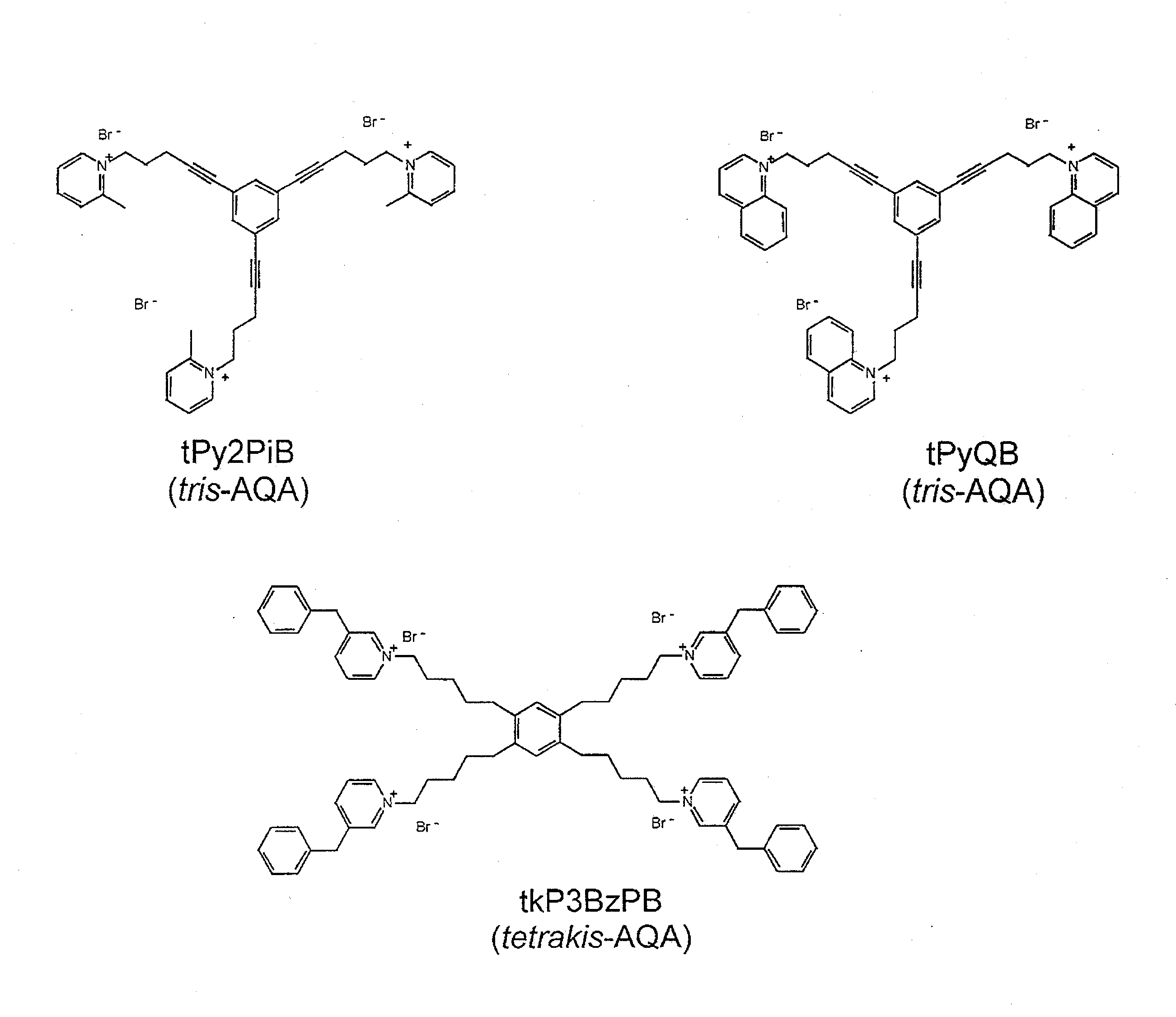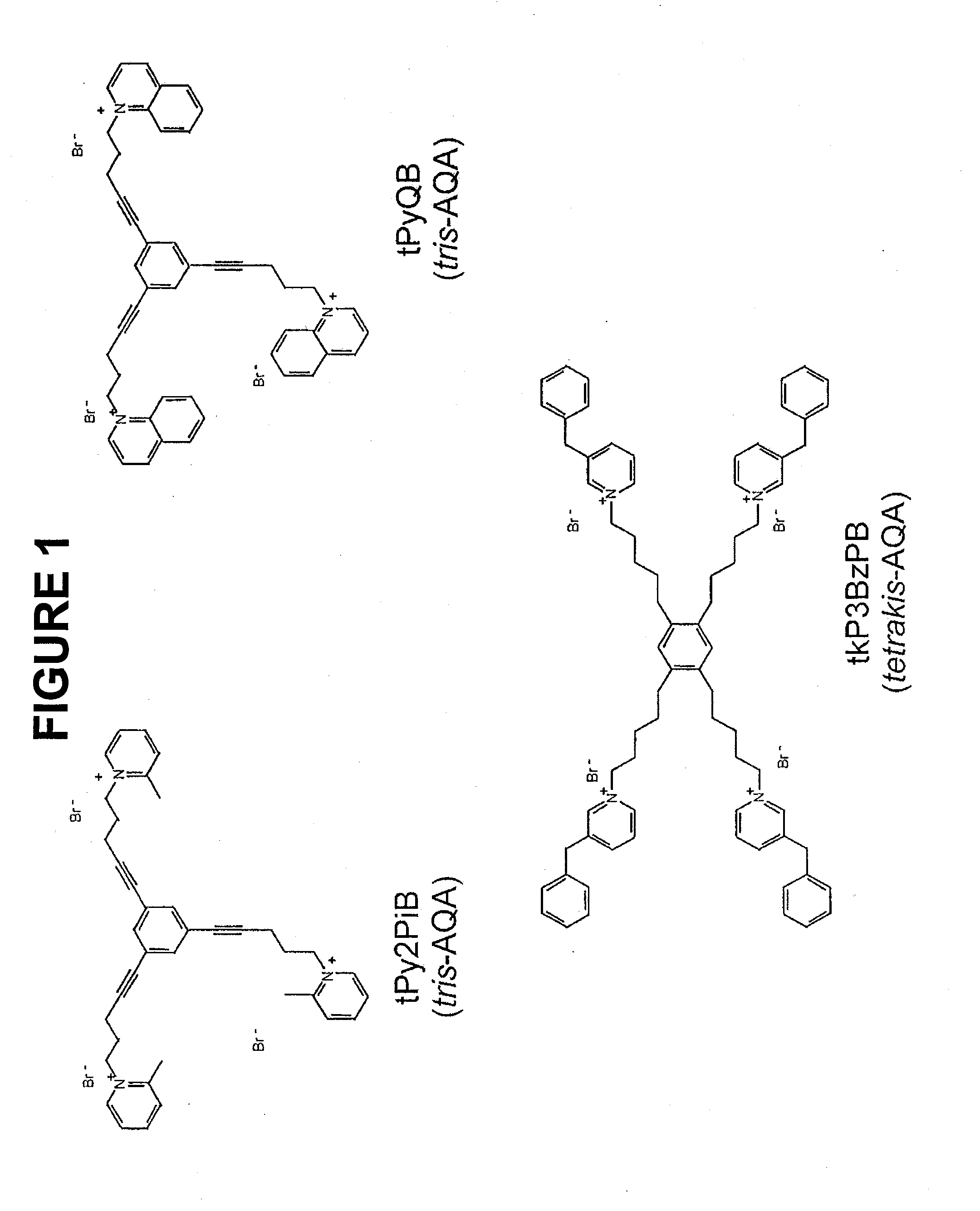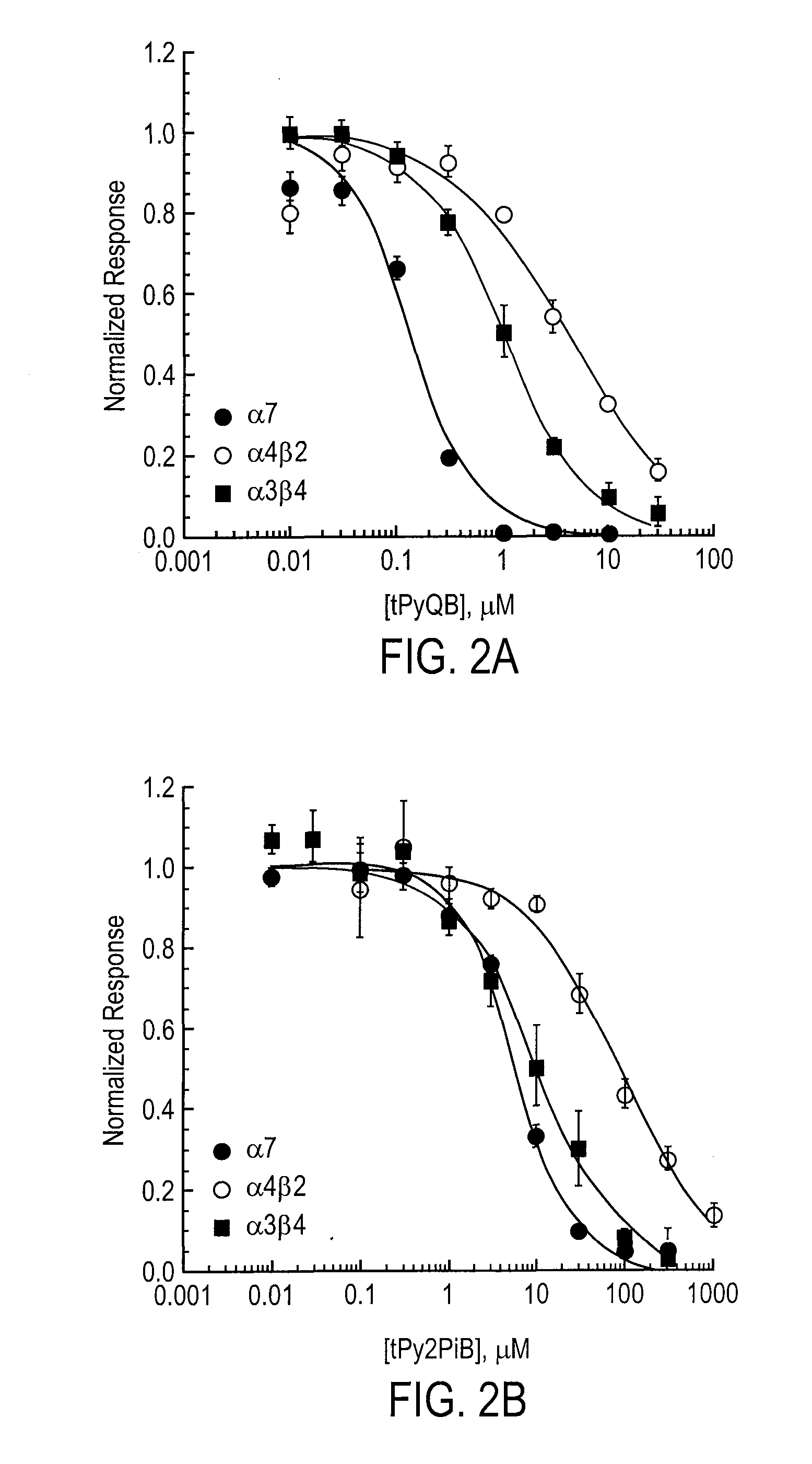USE OF A NOVEL ALPHA-7 nAChR ANTAGONIST TO SUPPRESS PATHOGENIC SIGNAL TRANSDUCTION IN CANCER AND AIDS
a technology of pathogenic signal and an antagonist, which is applied in the direction of biocide, halogenated hydrocarbon active ingredients, drug compositions, etc., can solve the problems of premature cell death and often fatal metastatic disease of a carcinoma
- Summary
- Abstract
- Description
- Claims
- Application Information
AI Technical Summary
Problems solved by technology
Method used
Image
Examples
example 1
Chemicals
[0116]tris- and tetrakis-AQA analogs were prepared as previously described (Dwoskin et al. (2008) J Pharmacol Exp Ther 326(2):563-576; Zheng et al. (2007) Bioorg Med Chem Lett 17(24):6701-6706). All other chemicals for electrophysiology were obtained from Sigma Chemical Co. (St. Louis, Mo.).
nAChR Expression in Xenopus oocytes
[0117]For recombinant nAChR studies, mature (>9 cm) female Xenopus laevis African frogs (Nasco, Ft. Atkinson, Wis.) were used as a source of oocytes. Prior to surgery, frogs were anesthetized by placing the animal in a 1.5 g / l solution of MS222 (3-aminobenzoic acid ethyl ester) for 30 min. Oocytes were removed from an incision made in the abdomen. All procedures involving frogs were approved by the University of Florida Institutional Animal Care and Use Committee (IACUC).
[0118]To remove the follicular cell layer, harvested oocytes were treated with 1.25 mg / ml type 1 collagenase (Worthington Biochemicals, Freehold, N.J.) for 2 h at room temperature in ca...
example 2
Preparation of 1,3,5-tris-(5-hydroxypent-1-ynyl)-benzene
[0135]
[0136]1,3,5-Tribromobenzene (10 g, 31.76 mmol), 4-pentyn-1-ol (10.69 g, 127.06 mmol) and bis(triphenylphosphine)palladium(II) dichloride were stirred in triethylamine under nitrogen for 5 minutes. Copper(I) iodide (92 mg, 0.48 mmol) was added and the mixture was stirred for 6 hours at 80° C. The mixture was cooled to room temperature, filtered through a celite pad and rinsed with ethyl acetate. The combined filtrate was evaporated to dryness under reduced pressure. The resulting residue was purified by column chromatography (CHCl3:MeOH 10:1) to afford 7.61 g of 1,3,5-tris-(5-hydroxy-1-pentynyl)-benzene. Yield: 74%. 1H NMR (300 MHz, CDCl3) δ 7.31 (3, 3 h), 3.81 (t, J=6.0 Hz, 6H), 2.52 (t, J=6.9 Hz, 6H), 1.85 (m, 6H); 13C NMR (75 MHz, CDCl3) δ 133.8, 124.2, 90.5, 80.0, 61.9, 31.5, 16.2 ppm.
example 3
Preparation of 1,3,5-tris-(5-bromopent-1-ynyl)-benzene
[0137]
[0138]1,3,5-tris-(5-hydroxy-1-pentynyl)-benzene (1.86 g, 5.73 mmol) and carbon tetrabromide (7.41 g, 22.35 mmol) were dissolved in dry methylene chloride (40 mL) and cooled to 0° C. Triphenyl phosphine (6.16 g, 23.47 mmol) was added dropwide and the mixture was stirred at 0° C. for 30 minutes. The mixture was poured into hexanes (200 mL), filtered through a short silica gel column and washed with ethyl acetate / hexanes (1 / 4). The combined organic solvents were evaporated to dryness under reduced pressure. The resulting residue was purified by column chromatography (hexanes:ethyl acetate 10:1) to afford 2.63 g of 1,3,5-tris-(5-bromopent-1-ynyl)-benzene. Yield 89%. 1H NMR (300 MHz, CDCl3) δ 7.33 (s, 3H), 3.57 (t, J=6.3 Hz), 2.60 (t, J=6.9 Hz, 6H), 2.12 (m, 6H) ppm; 13C NMR (75 MHz, CDCl3) δ 133.9, 124.1, 89.2, 80.4, 32.6, 31.7, 18.4 ppm.
PUM
| Property | Measurement | Unit |
|---|---|---|
| pH | aaaaa | aaaaa |
| temperature | aaaaa | aaaaa |
| holding currents | aaaaa | aaaaa |
Abstract
Description
Claims
Application Information
 Login to View More
Login to View More - R&D
- Intellectual Property
- Life Sciences
- Materials
- Tech Scout
- Unparalleled Data Quality
- Higher Quality Content
- 60% Fewer Hallucinations
Browse by: Latest US Patents, China's latest patents, Technical Efficacy Thesaurus, Application Domain, Technology Topic, Popular Technical Reports.
© 2025 PatSnap. All rights reserved.Legal|Privacy policy|Modern Slavery Act Transparency Statement|Sitemap|About US| Contact US: help@patsnap.com



